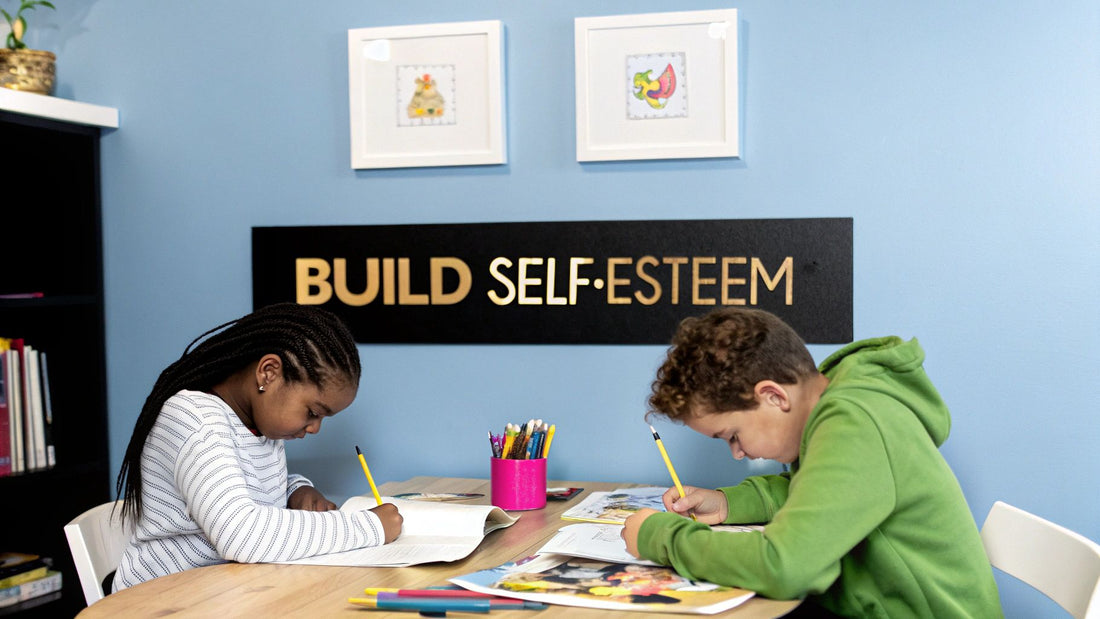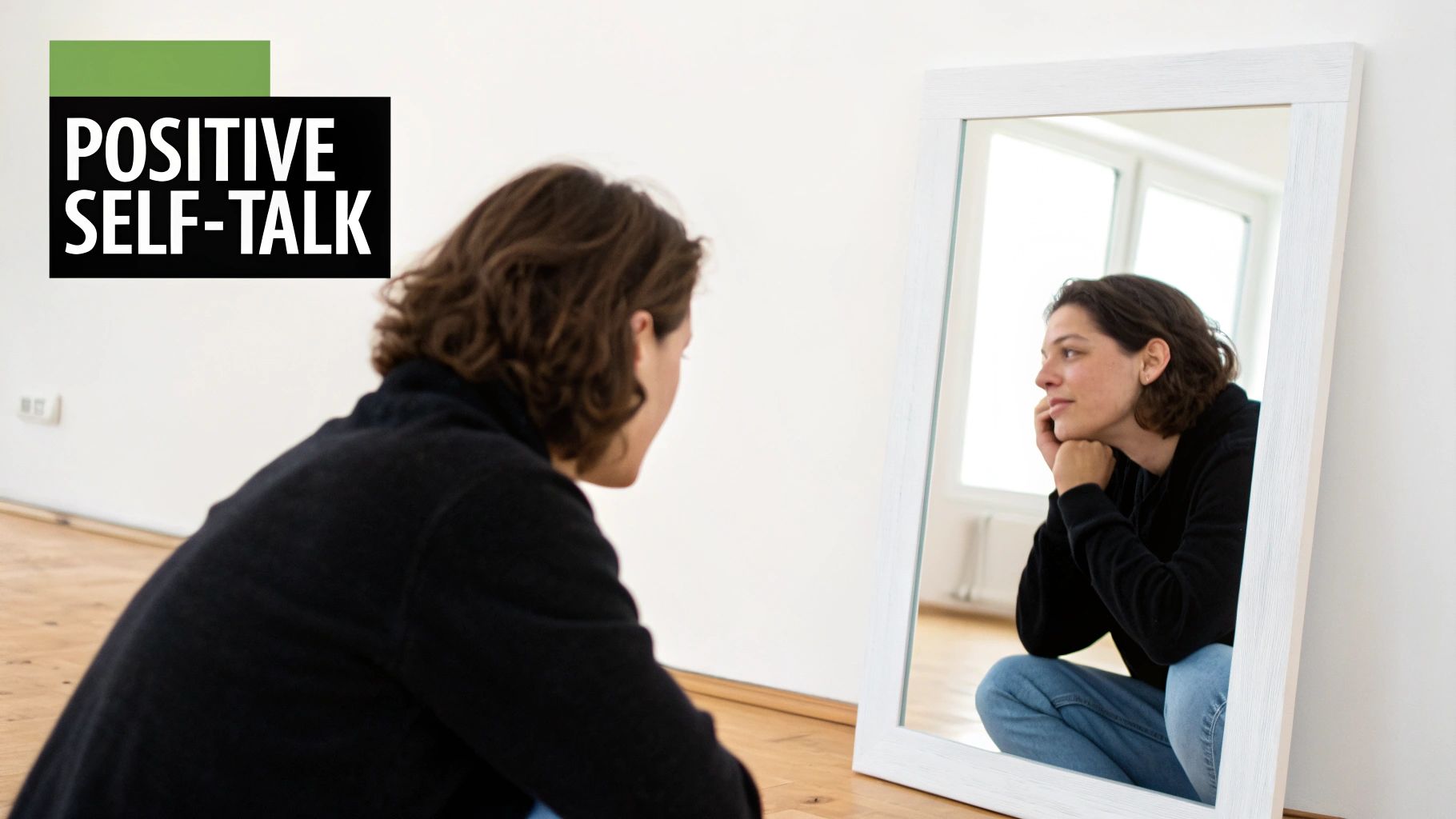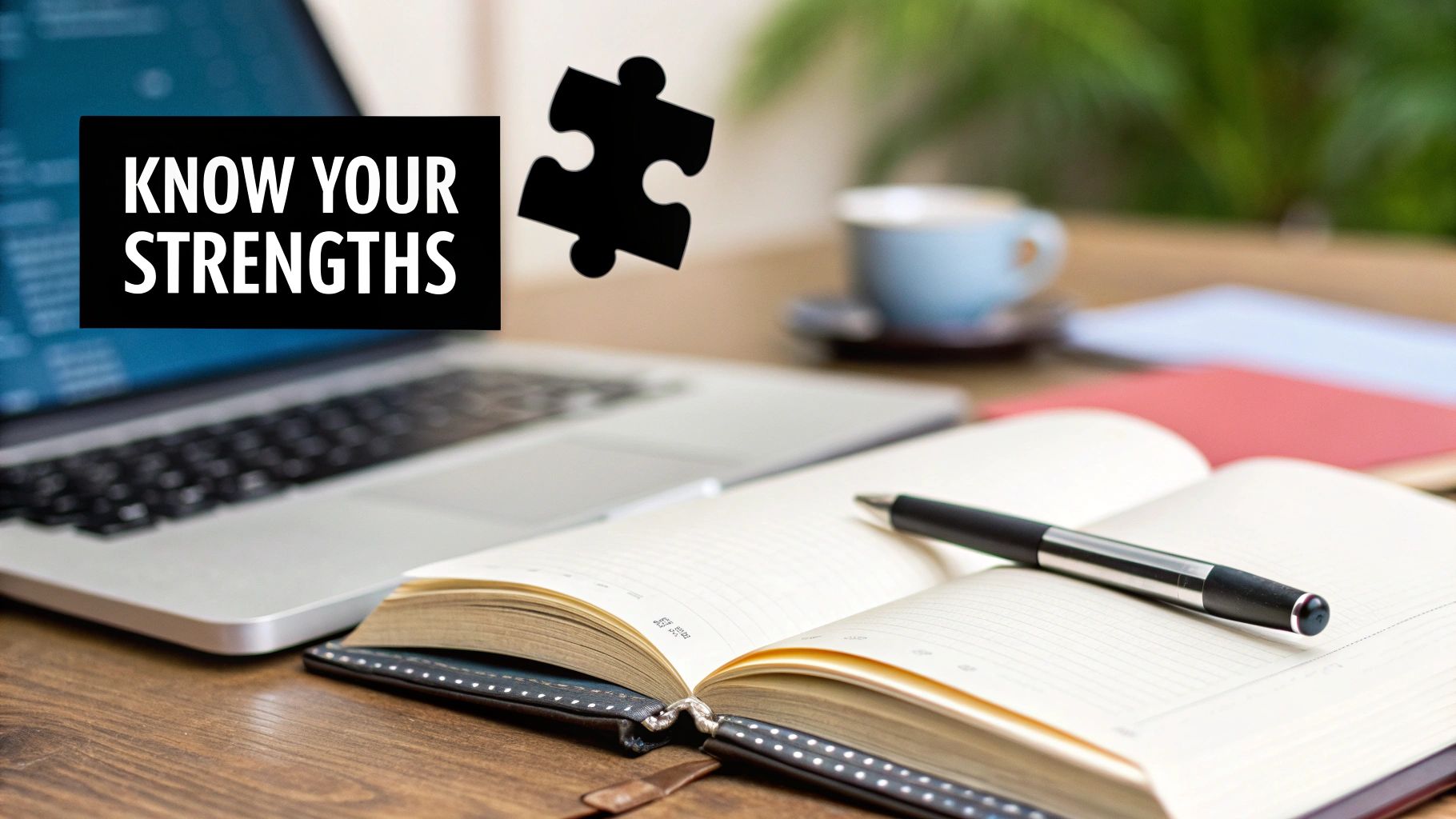
8 Self-Esteem Building Exercises for Young Minds in 2025
Share
In an increasingly complex world, a child's self-esteem serves as their emotional armour. Recent statistics reveal a concerning rise in mental health challenges among young people, with data suggesting that one in five children now has a probable mental health condition. This landscape is shaped by academic pressures and the pervasive influence of social media, where curated perfection often distorts reality. Understanding the impact of filtered social media images on self-perception is a crucial first step for parents and educators in helping children navigate these pressures.
Neglecting mental wellbeing carries significant long-term costs, not just for individuals but for society and future workplaces. Poor mental health costs UK businesses up to £56 billion a year. Building a strong foundation of self-worth is therefore not a luxury; it is a fundamental component of raising a healthy, resilient adult. This article provides a curated selection of practical self-esteem building exercises designed to equip children and young people with the tools they need. You will discover actionable strategies, from Positive Self-Talk Reframing to Values-Based Goal Setting, that you can implement immediately. These are not abstract theories but tangible methods to help nurture a robust sense of self.
Disclaimer: I am not a mental health professional. The information provided is for educational purposes only. If you have serious concerns about a child's mental health, please consult a GP or a qualified mental health practitioner.
1. The 'Positive Reframe' Game: Rewriting Their Inner Monologue
The internal monologue, or self-talk, is a powerful force that shapes a child's perception of themselves and the world. This exercise, rooted in the principles of Cognitive Behavioural Therapy (CBT), is one of the most effective self-esteem building exercises because it directly addresses and reshapes this inner voice. The goal is to help children catch automatic negative thoughts and consciously reframe them into more balanced, compassionate and realistic statements.

This isn't about ignoring difficulties or forcing toxic positivity. Instead, it’s about shifting from a critical to a constructive mindset. By learning to challenge harsh self-judgements, children build resilience and develop a more supportive inner dialogue that will serve them throughout their lives.
How to Implement the Positive Reframe
The core of this activity is turning an unhelpful thought into a helpful one. You can make this a gentle, consistent practice.
- Catch the Thought: Encourage children to notice when they say something negative about themselves. This could be out loud ("I'm so stupid, I can't do this puzzle") or an internal feeling of frustration.
- Challenge It: Ask gentle, guiding questions. A powerful one is, "What would you say to a friend who felt this way?" This helps them access their natural empathy and apply it to themselves.
- Reframe It: Help them find a new sentence. For example, "I'm rubbish at drawing" can become, "My drawing isn't how I want it yet, but I'm getting better with practice."
Practical Tips for Success
- Use a 'Thought Catcher' Jar: Have children write down negative thoughts on a small piece of paper, scrunch it up, and "trap" it in a jar. Later, you can take them out and work together to reframe them.
- Model the Behaviour: Let them hear you do it. If you make a mistake, say something like, "Oops, I forgot to buy milk. That's frustrating, but it's not a big deal. I'll add it to tomorrow's list." This shows them that everyone makes mistakes and self-criticism isn't the default response.
- Explore Emotional Literacy Books: Resources like the books from Little Fish Books can provide stories and characters that help children understand and articulate complex feelings, making it easier to identify the thoughts behind them. This can be a great way to introduce the concept of using positive affirmations to support mental health.
2. Daily Accomplishment Journaling
The human brain has a negativity bias, meaning we often focus on mistakes and setbacks more than on successes. This exercise, popularised in various forms by figures like Julia Cameron and embraced by positive psychology, is one of the most practical self-esteem building exercises because it actively counteracts this bias. The goal is to create a daily habit of recognising and recording achievements, no matter how small, to build a concrete record of personal competence and progress.

This practice helps children and young people shift their focus from perceived failures to tangible successes. Over time, reviewing this journal proves that they are capable, resilient and constantly growing. This evidence-based approach provides a powerful antidote to feelings of inadequacy and reinforces a positive self-concept.
How to Implement Daily Accomplishment Journaling
The core of this activity is consistently noting down things one has done well. This should be a low-pressure, reflective practice.
- Set a Time: Dedicate a few minutes each day, perhaps before bed, to reflect on the day and write. Consistency is key to building the habit.
- Focus on 'Small' Wins: Emphasise that accomplishments don't have to be monumental. A success could be finishing homework, helping a sibling, tidying their room, or even just managing a difficult emotion without an outburst. For example, a child might write, "Today I helped my little sister with her shoes."
- Review and Reflect: At the end of each week, read through the entries together. Ask questions like, "What do you notice about your week?" or "Which accomplishment made you feel the proudest?"
Practical Tips for Success
- Use Prompts: For children who find it hard to start, use simple prompts like, "Today I was proud that I..." or "Something I did well today was...". This gives them a clear starting point.
- Model the Behaviour: Share your own daily accomplishments. Saying, "I'm proud that I managed to finish a big project at work today, even though it was tricky," shows them that adults also value small victories.
- Utilise Structured Resources: For those who benefit from a more guided approach, there are many tools available. You can explore a variety of self-esteem worksheets that can help structure this journaling practice and make it more engaging for younger children.
3. Strengths Identification and Application: Building Confidence from Within
Focusing on what we're good at, rather than fixating on our weaknesses, is a cornerstone of authentic self-esteem. This exercise moves beyond simple compliments to a more structured process of identifying, acknowledging and actively using core personal strengths. Based on the work of positive psychology pioneers like Donald Clifton and Marcus Buckingham, this approach helps children and adults build confidence based on their genuine talents and character.

This method isn't about ignoring areas for development. Instead, it’s about understanding that leaning into our natural abilities creates energy, motivation and a powerful sense of competence. By consciously applying these strengths in school, hobbies and relationships, children learn that they possess valuable tools to navigate challenges and achieve their goals, making this one of the most empowering self-esteem building exercises.
How to Implement Strengths Identification
The goal is to help your child create a clear picture of their unique strengths and find opportunities to use them every day.
- Discover Their Strengths: Use age-appropriate tools or simple observation. For younger children, you could create "Strength Spotting" moments, noticing when they show kindness, creativity, or perseverance. For teens, free online versions of character strength surveys can be a great starting point.
- Create a Strengths Profile: Help them write down their top 3-5 strengths. This could be a colourful poster for their room or a note in their school diary. Seeing their strengths written down makes them more tangible and real.
- Plan to Apply Them: Brainstorm how they can use a specific strength this week. If "creativity" is a strength, could they design a new game? If "kindness" is a strength, could they plan a kind act for a family member?
Practical Tips for Success
- Ask for Outside Input: Encourage your child to ask a trusted teacher, grandparent, or friend what they see as their biggest strengths. Hearing it from others can be incredibly validating and offer a fresh perspective.
- Model the Behaviour: Talk about your own strengths. You could say, "I'm feeling a bit stuck on this project, so I'm going to use my 'organisation' strength to make a clear plan." This normalises self-awareness and strategic thinking.
- Connect Strengths to Goals: Help them see how their natural talents can help them achieve something they care about. For example, "You're really persistent, and that's exactly the strength you'll need to master that tricky part of the song on your guitar."
4. Gratitude Practice for Self-Appreciation
Gratitude is often directed outwards, towards others or circumstances. This powerful exercise turns that focus inward, encouraging children and young people to appreciate their own qualities, efforts and growth. This practice, influenced by the work of researchers like Dr Robert Emmons on gratitude and Kristin Neff on self-compassion, shifts attention from self-criticism to self-recognition, building a strong foundation of self-worth.

Learning to be grateful for oneself is a cornerstone of robust mental health. It helps children realise their intrinsic value is not solely dependent on external achievements or validation from others. This form of self-appreciation is one of the most sustainable self-esteem building exercises because it cultivates an internal source of encouragement that can be drawn upon during difficult times.
How to Implement Gratitude for Self-Appreciation
The goal is to make acknowledging personal strengths and efforts a regular habit. This can be integrated into daily routines like bedtime or family meals.
- Prompt Self-Reflection: Ask direct but gentle questions. For instance, "What is one thing you did today that you feel proud of?" or "What's a kind thing you did for someone else?"
- Acknowledge Qualities: Guide them to think beyond actions. Ask, "What is a personal quality you like about yourself? Maybe that you are a good friend, or that you are creative?"
- Connect Effort to Feeling: Help them link their hard work to a sense of pride. A student studying for a tough exam can be encouraged to appreciate their own discipline, regardless of the final mark.
Practical Tips for Success
- Create a Self-Gratitude Journal: Dedicate a notebook where children can write or draw three things they appreciate about themselves each day. This creates a tangible record of their positive attributes.
- Focus on Effort, Not Just Outcomes: Praise and encourage gratitude for the process. For example, appreciate the resilience shown during a difficult sports match, not just whether they won or lost. This builds a growth mindset.
- Model Self-Appreciation: Let your child hear you acknowledge your own strengths. You might say, "I felt really patient today when I was working on that difficult project, and I'm proud of myself for that."
5. Values-Based Goal Setting and Achievement
External validation, such as praise or social media likes, provides a fleeting boost to self-esteem. This exercise builds a more robust and authentic sense of self-worth by connecting goals to a child's core personal values. Popularised by thinkers like Stephen Covey and Brené Brown, this approach is one of the most meaningful self-esteem building exercises because it shifts the focus from external approval to internal alignment. The goal is to help a child identify what truly matters to them and then use those principles as a compass for their actions and aspirations.
This isn't about setting grand, life-changing goals from the start. It is about fostering a sense of purpose and integrity. When a child's efforts are aligned with their authentic values, such as kindness, creativity, or fairness, the act of striving becomes inherently rewarding. This process builds a deep, unshakable confidence that comes from living in a way that feels true to who they are.
How to Implement Values-Based Goal Setting
The core of this activity is linking what a child does with who they want to be. It transforms goal-setting from a chore into an expression of their identity.
- Identify Core Values: Start a conversation about what's important. Ask questions like, "What makes you feel proud?" or "When do you feel happiest?" Help them distil these ideas into value words like ‘honesty,’ ‘helping others,’ ‘learning,’ or ‘adventure.’ You can use a list of value words to help them choose their top 3-5.
- Set an Aligned Goal: Connect a tangible goal to one of their chosen values. For a child who values ‘helping others,’ a goal could be to volunteer for a local charity or organise a small fundraiser at school.
- Celebrate the Process: Shift the focus from just the final outcome to the effort and alignment. Celebrate the steps they take towards their goal, reinforcing that living by their values is the real victory. For instance, praise the courage it took to sign up to volunteer, not just the completion of the volunteering itself.
Practical Tips for Success
- Create a Values Vision Board: Instead of just cutting out pictures of material items, encourage them to find images, words, and quotes that represent their core values in action. This visual reminder can keep them motivated.
- Model the Behaviour: Talk about your own values and how they guide your decisions. For example, "I'm choosing to spend Saturday morning at the park with you instead of working because 'family' is one of my most important values."
- Review and Reflect Regularly: Set aside time every month to check in. Ask, "How did you live out your value of 'creativity' this month?" or "Is your goal still feeling important to you?" This teaches them that both values and goals can be reflected upon and adjusted.
6. Body Neutrality and Physical Self-Acceptance
In a world saturated with media images and social media pressures, developing a healthy relationship with one's body is a monumental challenge. This exercise focuses on body neutrality, a concept that shifts the focus from loving or hating one's appearance to simply respecting and accepting the body for what it can do. It's one of the most vital self-esteem building exercises for children today, as it provides a powerful antidote to appearance-based anxiety.
The goal isn't to force a feeling of love for one's body, which can feel inauthentic for many. Instead, it's about appreciating its functionality and worth beyond its aesthetic value. This practice, championed by advocates like Sonya Renee Taylor and rooted in movements like intuitive eating, helps children build a foundation of self-worth that isn't dependent on the fluctuating standards of physical appearance.
How to Implement Body Neutrality
The core of this practice is to acknowledge and appreciate the body’s capabilities, moving away from a constant critique of its looks. This can be integrated into daily conversations and mindsets.
- Focus on Function: Encourage children to think about what their bodies allow them to do. Instead of commenting on how their legs look, talk about how those legs help them run, jump, and play football with their friends.
- Challenge Negative Talk: When a child says something negative about their appearance ("I hate my hair"), gently challenge it. You could ask, "What is something you appreciate about your body today? Maybe how strong your arms are for climbing?"
- Model Neutral Language: Avoid commenting on your own or others' weight, shape, or appearance. Instead, model language that focuses on health, energy and ability, such as, "I feel so energised after that walk," rather than, "I need to walk to burn off that cake."
Practical Tips for Success
- Gratitude for Function: Start a daily practice where each family member names one thing they are grateful for their body doing that day. For example, "I'm grateful for my hands that let me build with my LEGO bricks."
- Joyful Movement: Frame physical activity as a fun experience, not a chore or a way to change one's body. Focus on activities the child genuinely enjoys, like dancing, swimming, or cycling, which reinforces the body's role in providing pleasure and strength.
- Curate Media Intake: Be mindful of the social media, TV shows and magazines your child consumes. Surround them with body-positive and neutral influences that celebrate diversity in all shapes, sizes and abilities. This helps normalise a wider range of body types.
7. Boundary Setting and Assertiveness Training
Understanding and communicating personal boundaries is a cornerstone of self-respect. This skill-building exercise teaches children and young people how to identify their limits, articulate them clearly and maintain them respectfully. As one of the most empowering self-esteem building exercises, it shifts the focus from seeking external validation to cultivating internal strength and self-advocacy.
This practice is not about building walls or being confrontational; it’s about creating a safe emotional and physical space. When individuals learn to say "no" to things that drain them or make them uncomfortable, they are simultaneously saying "yes" to their own wellbeing and worth. This fosters a profound sense of agency and teaches others how to treat them with the respect they deserve.
How to Implement Assertiveness Training
The goal is to help individuals communicate their needs and limits without aggression or passivity. This can be practised through role-playing and real-life application.
- Identify the Boundary: Help them recognise their feelings. Ask, "What about that situation made you feel uncomfortable or unhappy?" This helps pinpoint the specific limit that was crossed.
- Use 'I' Statements: Teach them to frame their needs from their own perspective to avoid sounding accusatory. For example, instead of "You're annoying me," try "I feel frustrated when I'm interrupted."
- Practise Scenarios: Role-play common situations. For example, a friend who wants to copy homework, a family member who makes a teasing comment, or pressure to join in with social media trends that make them uncomfortable.
Practical Tips for Success
- Start Small: Encourage them to set small, low-stakes boundaries first, such as, "I'd prefer not to talk about that right now," or "I need some quiet time to myself." Success in these minor situations builds confidence for bigger ones.
- Say 'No' Gracefully: Teach them that a simple "No, thank you" is a complete sentence. They do not need to over-explain or justify their decision, which can often weaken the boundary.
- Stay Consistent: Explain that people may test new boundaries, not out of malice but out of habit. The key is gentle but firm consistency. This reinforces their self-respect and helps others adjust to the new dynamic.
8. Self-Compassion and Loving-Kindness Practice
Often, we teach children to be kind to others but forget to teach them how to be kind to themselves. This exercise, popularised by researchers like Dr Kristin Neff, is one of the most profound self-esteem building exercises because it cultivates an inner ally rather than an inner critic. The practice involves directing feelings of warmth, goodwill and kindness towards oneself, especially during moments of perceived failure or difficulty.
This isn't about ignoring mistakes or creating excuses. It’s about learning to treat oneself with the same care and understanding one would offer a dear friend. By developing self-compassion, young people build a foundation of emotional resilience that protects their self-worth from the inevitable ups and downs of life, helping them navigate academic stress or social pressures with a kinder internal voice.
How to Implement Loving-Kindness
The goal is to foster a gentle, supportive inner environment through mindful intention. This can be introduced as a quiet, calming activity.
- Find a Calm Space: Ask the child to sit comfortably and take a few slow, deep breaths to settle their body and mind. Try a simple breathing exercise like 'box breathing': inhale for four counts, hold for four, exhale for four and hold for four.
- Introduce Gentle Phrases: Guide them to silently repeat phrases directed at themselves. Classic examples include: "May I be happy," "May I be safe," "May I be healthy," and "May I live with ease."
- Connect with Feeling: Encourage them to notice the feeling of warmth or kindness that these phrases might create. If their mind wanders, gently guide them back to the phrases without judgement.
Practical Tips for Success
- Start Small: Begin with short, 5-minute guided sessions. There are many free guided meditations for loving-kindness available online specifically for children.
- Use 'Self-Compassion Breaks': In a difficult moment, teach them to pause, acknowledge the feeling ("This is a moment of suffering"), and offer themselves a kind phrase ("May I be kind to myself"). This is a powerful in-the-moment tool.
- Extend to Others: Once they are comfortable directing kindness inward, you can expand the practice to include others (friends, family, even someone they find difficult), which helps in teaching emotional awareness and compassion for the wider world.
- Model It Yourself: Let children see you treating yourself with kindness. If you're having a tough day, you might say, "I'm feeling a bit overwhelmed today, so I'm going to take a few quiet minutes to be kind to myself." This normalises self-care as a valid response to stress.
Self-Esteem Exercises Comparison Matrix
| Practice | Implementation Complexity 🔄 | Resource Requirements ⚡ | Expected Outcomes 📊 | Ideal Use Cases 💡 | Key Advantages ⭐ |
|---|---|---|---|---|---|
| Positive Self-Talk Reframing | Moderate 🔄 Requires consistent practice | Low ⚡ Can be done anytime, no cost | Improved thought patterns, long-term mental resilience | Anyone facing negative self-talk, anxiety, performance stress | Scientifically backed, accessible, builds resilience |
| Daily Accomplishment Journaling | Low 🔄 Requires daily discipline | Low ⚡ Needs only pen and paper or app | Increased self-awareness, motivation, track progress | Those needing motivation, tracking progress, improving focus | Builds objective evidence of success |
| Strengths Identification & Application | Moderate to High 🔄 May need assessments | Moderate ⚡ Some tools may be paid | Greater confidence, authentic self-esteem | Career coaching, education, personal development | Based on validated tools, research-backed |
| Gratitude Practice for Self-Appreciation | Low 🔄 Simple but requires consistency | Low ⚡ Flexible format (writing, meditation) | Increased well-being, positive emotional states | Anyone seeking improved mental health, self-compassion | Easy integration, strong research support |
| Values-Based Goal Setting & Achievement | Moderate 🔄 Time-consuming reflection | Low to Moderate ⚡ Mostly time & reflection | Authentic motivation, sustainable confidence | Goal-driven individuals aligning actions with values | Builds intrinsic motivation, reduces social comparison |
| Body Neutrality & Physical Self-Acceptance | Moderate 🔄 May be challenging initially | Low ⚡ Practice-based, may need support | Improved body image, resilience to social pressure | Individuals with body image issues, athletes, recovering patients | Reduces self-criticism, supports healthy habits |
| Boundary Setting & Assertiveness Training | High 🔄 Involves skill-building and practice | Low to Moderate ⚡ Practice and possible coaching | Better relationships, increased self-respect | Anyone needing healthier relationships or self-advocacy skills | Develops essential communication skills |
| Self-Compassion & Loving-Kindness Practice | Moderate 🔄 Requires regular meditation | Low ⚡ Can be done alone or guided | Reduced stress, emotional resilience, better self-worth | Individuals with self-criticism, perfectionism, burnout | Strong mental health benefits, well-researched |
Building a Toolkit for Lifelong Emotional Wellbeing
Navigating the journey of building self-esteem is not about finding a single, magical solution. Instead, it’s about carefully curating a personal toolkit of strategies that a child or young person can draw upon throughout their life. The exercises we’ve explored, from Positive Self-Talk Reframing to Self-Compassion Practices, are the foundational tools in this kit. Each one offers a unique way to cultivate a resilient and compassionate inner voice.
Think of these practices not as one-off tasks, but as habits to be nurtured over time. The true power of these self-esteem building exercises lies in their consistent application. Daily Accomplishment Journaling builds a tangible record of competence, while Gratitude Practice shifts focus towards inherent worth and away from external validation. Similarly, Values-Based Goal Setting gives a young person a sense of purpose and agency over their own life, transforming them from a passive observer to an active participant in their own growth.
Integrating These Practices into Daily Life
The key to making these exercises stick is to weave them into the fabric of your family or classroom routine. This isn't about adding more to an already packed schedule; it's about transforming existing moments.
- Morning Routine: Start the day with a simple positive affirmation or a moment of self-compassion.
- Dinnertime Conversation: Discuss one small accomplishment from the day or one thing everyone is grateful for.
- Bedtime Reflection: Use journaling as a quiet, reflective activity to wind down. For those new to this, learning how to start journaling for self-discovery and mental clarity can be a powerful supplementary skill for both you and your child.
Remember that you are a powerful role model. When adults openly practise self-compassion, set healthy boundaries, and talk about their own strengths, they give children permission to do the same. This can even extend to simple acts, like wearing mental health apparel with positive messaging, which normalises these important conversations.
Your Path Forward: Progress, Not Perfection
The goal is not to achieve a perfect, unwavering state of high self-esteem, but to build the skills needed to navigate the natural ups and downs of life with greater resilience. It’s about teaching a child that their worth is not conditional on their performance or others' opinions. By equipping them with these tools, you are giving them an invaluable gift: the ability to understand, accept, and value themselves for exactly who they are.
While these exercises are a fantastic support system, it is crucial to recognise when professional help may be needed. If you have persistent concerns about your child's mental health or a significant drop in their self-esteem, please do not hesitate to consult a GP or a registered mental health professional for guidance.
Ready to put these principles into practice with engaging, beautifully illustrated stories? Explore the collection at Little Fish Books. Our books are carefully crafted to introduce concepts like self-worth and emotional resilience to children in a way they can understand and connect with, making them the perfect companion to these self-esteem building exercises. Visit Little Fish Books to find resources that will support your child's journey to a stronger sense of self.
